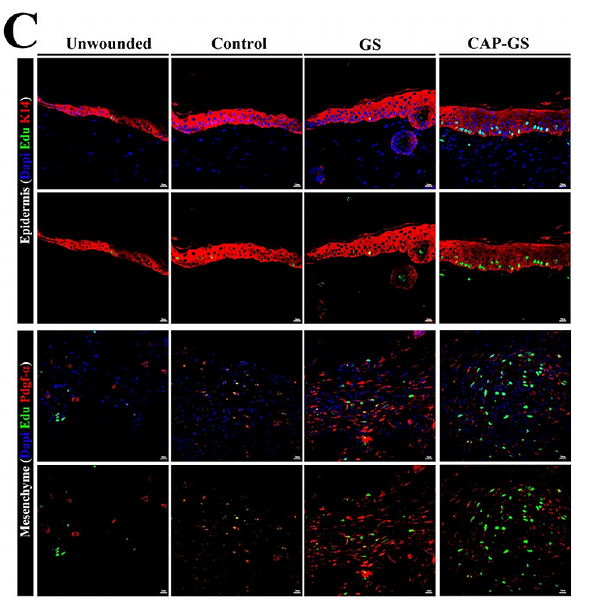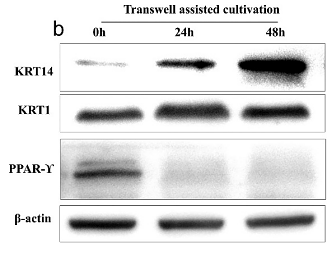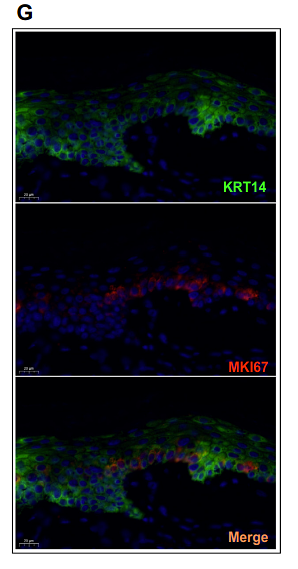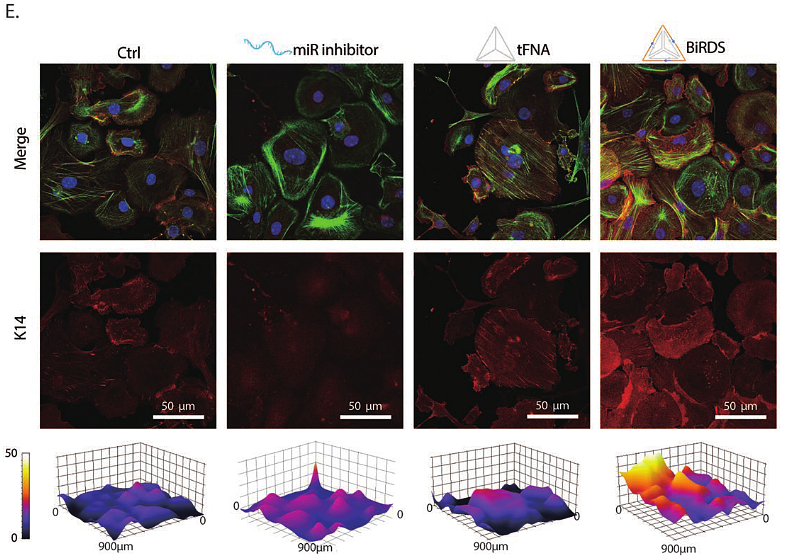Cytokeratin 14 Recombinant Rabbit Monoclonal Antibody [SC65-06]

Specification
Catalog# ET1610-42
Cytokeratin 14 Recombinant Rabbit Monoclonal Antibody [SC65-06]
-
WB
-
IF-Cell
-
IF-Tissue
-
IHC-P
-
FC
-
Human
-
Mouse
-
Rat
Overview
Product Name
Cytokeratin 14 Recombinant Rabbit Monoclonal Antibody [SC65-06]
Antibody Type
Recombinant Rabbit monoclonal Antibody
Immunogen
Recombinant protein within Mouse Cytokeratin 14 aa 250-484 / 484.
Species Reactivity
Human, Mouse, Rat
Validated Applications
WB, IF-Cell, IF-Tissue, IHC-P, FC
Molecular Weight
Predicted band size: 51 kDa
Positive Control
A431 cell lysate, mouse skin tissue lysate, B16F1, SW480, HepG2, human cervical carcinoma tissue, human skin tissue, rat skin tissue, mouse skin tissue, mouse prostate tissue.
Conjugation
unconjugated
Clone Number
SC65-06
RRID
Product Features
Form
Liquid
Storage Instructions
Shipped at 4℃. Store at +4℃ short term (1-2 weeks). It is recommended to aliquot into single-use upon delivery. Store at -20℃ long term.
Storage Buffer
1*TBS (pH7.4), 0.05% BSA, 40% Glycerol. Preservative: 0.05% Sodium Azide.
Isotype
IgG
Purification Method
Protein A affinity purified.
Application Dilution
-
WB
-
1:2,000
-
IF-Cell
-
1:100-1:500
-
IF-Tissue
-
1:100-1:500
-
IHC-P
-
1:100-1:1,500
-
FC
-
1:1,000
Applications in Publications
Species in Publications
Target
Function
This gene encodes a member of the keratin family, the most diverse group of intermediate filaments. This gene product, a type I keratin, is usually found as a heterotetramer with two keratin 5 molecules, a type II keratin. Together they form the cytoskeleton of epithelial cells. Mutations in the genes for these keratins are associated with epidermolysis bullosa simplex. The nonhelical tail domain is involved in promoting KRT5-KRT14 filaments to self-organize into large bundles and enhances the mechanical properties involved in resilience of keratin intermediate filaments in vitro. Expressed in the corneal epithelium (at protein level). Detected in the basal layer, lowered within the more apically located layers specifically in the stratum spinosum, stratum granulosum but is not detected in stratum corneum. Strongly expressed in the outer root sheath of anagen follicles but not in the germinative matrix, inner root sheath or hair. A form of epidermolysis bullosa simplex, a group of skin fragility disorders characterized by skin blistering due to cleavage within the basal layer of keratinocytes, and erosions caused by minor mechanical trauma. There is a broad spectrum of clinical severity ranging from minor blistering on the feet, to subtypes with extracutaneous involvement and a lethal outcome. EBS1A is an autosomal dominant form characterized by generalized intraepidermal skin blistering that begins and is very prominent at birth. EBS1A may be life-threatening in the first year of life. Tendency to blistering diminishes in adolescence.
Background References
1. Pastar I et al. Interactions of methicillin resistant Staphylococcus aureus USA300 and Pseudomonas aeruginosa in polymicrobial wound infection. PLoS One 8:e56846 (2013).
2. DeWard AD et al. Cellular heterogeneity in the mouse esophagus implicates the presence of a nonquiescent epithelial stem cell population. Cell Rep 9:701-11 (2014).
Sequence Similarity
Belongs to the intermediate filament family.
Tissue Specificity
Expressed in the corneal epithelium (at protein level). Detected in the basal layer, lowered within the more apically located layers specifically in the stratum spinosum, stratum granulosum but is not detected in stratum corneum. Strongly expressed in the outer root sheath of anagen follicles but not in the germinative matrix, inner root sheath or hair. Found in keratinocytes surrounding the club hair during telogen.
Post-translational Modification
A disulfide bond is formed between rather than within filaments and promotes the formation of a keratin filament cage around the nucleus.; Ubiquitinated by the BCR(KLHL24) E3 ubiquitin ligase complex.
Subcellular Location
Cytoplasm, Nucleus.
Synonyms
CK 14 antibody
CK-14 antibody
ck14 antibody
Cytokeratin 14 antibody
Cytokeratin-14 antibody
Cytokeratin14 antibody
Dowling Meara antibody
EBS3 antibody
EBS4 antibody
Epidermolysis bullosa simplex antibody
ExpandCK 14 antibody
CK-14 antibody
ck14 antibody
Cytokeratin 14 antibody
Cytokeratin-14 antibody
Cytokeratin14 antibody
Dowling Meara antibody
EBS3 antibody
EBS4 antibody
Epidermolysis bullosa simplex antibody
K14 antibody
K1C14_HUMAN antibody
Keratin 14 (epidermolysis bullosa simplex, Dowling-Meara, Koebner) antibody
Keratin 14 antibody
Keratin antibody
Keratin type I cytoskeletal 14 antibody
Keratin, type I cytoskeletal 14 antibody
Keratin-14 antibody
Keratin14 antibody
Koebner antibody
Krt 14 antibody
Krt14 antibody
NFJ antibody
OTTHUMP00000164624 antibody
type I cytoskeletal 14 antibody
CollapseImages
-

☑ Relative expression (RE)
Western blot analysis of Cytokeratin 14 on different lysates with Rabbit anti-Cytokeratin 14 antibody (ET1610-42) at 1/2,000 dilution.
Lane 1: A431 cell lysate (15 µg/Lane)
Lane 2: PANC-1 cell lysate (negative) (15 µg/Lane)
Lane 3: NIH/3T3 cell lysate (negative) (15 µg/Lane)
Lane 4: PC-12 cell lysate (negative) (15 µg/Lane)
Lane 5: Mouse skin tissue lysate (20 µg/Lane)
Predicted band size: 51 kDa
Observed band size: 51 kDa
Exposure time: 24 seconds;
4-20% SDS-PAGE gel.
Proteins were transferred to a PVDF membrane and blocked with 5% NFDM/TBST for 1 hour at room temperature. The primary antibody (ET1610-42) at 1/2,000 dilution was used in 5% NFDM/TBST at 4℃ overnight. Goat Anti-Rabbit IgG - HRP Secondary Antibody (HA1001) at 1/50,000 dilution was used for 1 hour at room temperature. -

Immunocytochemistry analysis of A431 cells labeling Cytokeratin 14 with Rabbit anti-Cytokeratin 14 antibody (ET1610-42) at 1/500 dilution.
Cells were fixed in 4% paraformaldehyde for 20 minutes at room temperature, permeabilized with 0.1% Triton X-100 in PBS for 5 minutes at room temperature, then blocked with 1% BSA in 10% negative goat serum for 1 hour at room temperature. Cells were then incubated with Rabbit anti-Cytokeratin 14 antibody (ET1610-42) at 1/500 dilution in 1% BSA in PBST overnight at 4 ℃. Goat Anti-Rabbit IgG H&L (iFluor™ 488, HA1121) was used as the secondary antibody at 1/1,000 dilution. PBS instead of the primary antibody was used as the secondary antibody only control. Nuclear DNA was labelled in blue with DAPI.
Beta tubulin (M1305-2, red) was stained at 1/100 dilution overnight at +4℃. Goat Anti-Mouse IgG H&L (iFluor™ 594, HA1126) was used as the secondary antibody at 1/1,000 dilution. -

ICC staining of Cytokeratin 14 in B16F1 cells (green). Formalin fixed cells were permeabilized with 0.1% Triton X-100 in TBS for 10 minutes at room temperature and blocked with 1% Blocker BSA for 15 minutes at room temperature. Cells were probed with the primary antibody (ET1610-42, 1/50) for 1 hour at room temperature, washed with PBS. Alexa Fluor®488 Goat anti-Rabbit IgG was used as the secondary antibody at 1/1,000 dilution. The nuclear counter stain is DAPI (blue).
-

ICC staining of Cytokeratin 14 in SW480 cells (green). Formalin fixed cells were permeabilized with 0.1% Triton X-100 in TBS for 10 minutes at room temperature and blocked with 1% Blocker BSA for 15 minutes at room temperature. Cells were probed with the primary antibody (ET1610-42, 1/50) for 1 hour at room temperature, washed with PBS. Alexa Fluor®488 Goat anti-Rabbit IgG was used as the secondary antibody at 1/1,000 dilution. The nuclear counter stain is DAPI (blue).
-

ICC staining of Cytokeratin 14 in HepG2 cells (green). Formalin fixed cells were permeabilized with 0.1% Triton X-100 in TBS for 10 minutes at room temperature and blocked with 1% Blocker BSA for 15 minutes at room temperature. Cells were probed with the primary antibody (ET1610-42, 1/50) for 1 hour at room temperature, washed with PBS. Alexa Fluor®488 Goat anti-Rabbit IgG was used as the secondary antibody at 1/1,000 dilution. The nuclear counter stain is DAPI (blue).
-

Immunohistochemical analysis of paraffin-embedded human cervical carcinoma tissue with Rabbit anti-Cytokeratin 14 antibody (ET1610-42) at 1/1,000 dilution.
The section was pre-treated using heat mediated antigen retrieval with Tris-EDTA buffer (pH 9.0) for 20 minutes. The tissues were blocked in 1% BSA for 20 minutes at room temperature, washed with ddH2O and PBS, and then probed with the primary antibody (ET1610-42) at 1/1,000 dilution for 1 hour at room temperature. The detection was performed using an HRP conjugated compact polymer system. DAB was used as the chromogen. Tissues were counterstained with hematoxylin and mounted with DPX. -

Immunohistochemical analysis of paraffin-embedded human skin tissue with Rabbit anti-Cytokeratin 14 antibody (ET1610-42) at 1/1,500 dilution.
The section was pre-treated using heat mediated antigen retrieval with Tris-EDTA buffer (pH 9.0) for 20 minutes. The tissues were blocked in 1% BSA for 20 minutes at room temperature, washed with ddH2O and PBS, and then probed with the primary antibody (ET1610-42) at 1/1,500 dilution for 1 hour at room temperature. The detection was performed using an HRP conjugated compact polymer system. DAB was used as the chromogen. Tissues were counterstained with hematoxylin and mounted with DPX. -

Immunohistochemical analysis of paraffin-embedded human skin tissue with Rabbit anti-Cytokeratin 14 antibody (ET1610-42) at 1/1,500 dilution.
The section was not undergone antigen retrieval. The tissues were blocked in 1% BSA for 20 minutes at room temperature, washed with ddH2O and PBS, and then probed with the primary antibody (ET1610-42) at 1/1,500 dilution for 1 hour at room temperature. The detection was performed using an HRP conjugated compact polymer system. DAB was used as the chromogen. Tissues were counterstained with hematoxylin and mounted with DPX. -

Immunofluorescence analysis of paraffin-embedded rat skin tissue labeling Cytokeratin 14 (ET1610-42).
The section was pre-treated using heat mediated antigen retrieval with Tris-EDTA buffer (pH 9.0) for 20 minutes. The tissues were blocked in 10% negative goat serum for 1 hour at room temperature, washed with PBS. And then probed with the primary antibodies Cytokeratin 14 (ET1610-42, red) at 1/500 dilution at +4℃ overnight, washed with PBS.
Goat Anti-Rabbit IgG H&L (iFluor™ 594, HA1122) was used as the secondary antibodies at 1/1,000 dilution. Nuclei were counterstained with DAPI (blue). -

Immunofluorescence analysis of paraffin-embedded rat skin tissue labeling Cytokeratin 14 (ET1610-42) and Vimentin (EM0401).
The section was pre-treated using heat mediated antigen retrieval with Tris-EDTA buffer (pH 9.0) for 20 minutes. The tissues were blocked in 10% negative goat serum for 1 hour at room temperature, washed with PBS. And then probed with the primary antibodies Cytokeratin 14 (ET1610-42, red) at 1/400 dilution and Vimentin (EM0401, green) at 1/400 dilution at +4℃ overnight, washed with PBS.
Goat Anti-Rabbit IgG H&L (iFluor™ 594, HA1122) and Goat Anti-Mouse IgG H&L (iFluor™ 488, HA1125) were used as the secondary antibodies at 1/1,000 dilution. Nuclei were counterstained with DAPI (blue). -

Immunohistochemical analysis of paraffin-embedded mouse skin tissue using anti-Cytokeratin 14 antibody. The section was pre-treated using heat mediated antigen retrieval with Tris-EDTA buffer (pH 8.0-8.4) for 20 minutes.The tissues were blocked in 5% BSA for 30 minutes at room temperature, washed with ddH2O and PBS, and then probed with the primary antibody (ET1610-42, 1/50) for 30 minutes at room temperature. The detection was performed using an HRP conjugated compact polymer system. DAB was used as the chromogen. Tissues were counterstained with hematoxylin and mounted with DPX.
-

Immunohistochemical analysis of paraffin-embedded mouse prostate tissue using anti-Cytokeratin 14 antibody. The section was pre-treated using heat mediated antigen retrieval with Tris-EDTA buffer (pH 8.0-8.4) for 20 minutes.The tissues were blocked in 5% BSA for 30 minutes at room temperature, washed with ddH2O and PBS, and then probed with the primary antibody (ET1610-42, 1/50) for 30 minutes at room temperature. The detection was performed using an HRP conjugated compact polymer system. DAB was used as the chromogen. Tissues were counterstained with hematoxylin and mounted with DPX.
-

Flow cytometric analysis of A431 cells labeling Cytokeratin 14.
Cells were fixed and permeabilized. Then stained with the primary antibody (ET1610-42, 1μg/mL) (red) compared with Rabbit IgG Isotype Control (green). After incubation of the primary antibody at +4℃ for an hour, the cells were stained with a iFluor™ 488 conjugate-Goat anti-Rabbit IgG Secondary antibody (HA1121) at 1/1,000 dilution for 30 minutes at +4℃. Unlabelled sample was used as a control (cells without incubation with primary antibody; black).
Please note: All products are "FOR RESEARCH USE ONLY AND ARE NOT INTENDED FOR DIAGNOSTIC OR THERAPEUTIC USE"
Citation
-
Controlled Release of Cold Atmospheric Plasma by Gelatin Scaffold Enhances Wound Healing via Macrophage Modulation
Author: Nian Zhang, Guang Yang, Yan Wu, Liru Hu, Chengzhi Zhao, Hang-Hang Liu, Li Wu, Jian Pan, Xian Liu
PMID: 40013441

Journal: ACS Applied Materials & Interfaces
Application: IF
Reactivity: Mouse
Publish date: 2025 Feb
-
Citation
-
A bioswitchable delivery system for microRNA therapeutics based on a tetrahedral DNA nanostructure
Author: Li Songhang,et al
PMID: 39215132
Journal: Nature Protocols
Application: WB,IF
Reactivity: Mouse
Publish date: 2024 Sep
-
Citation
-
Study of pathological processes of meibomian gland dysfunction by in vitro culture airlifting conditions
Author:
PMID: 37216482

Journal: Journal Of Histotechnology
Application: IF,WB
Reactivity: Rat
Publish date: 2023 May
-
Citation
-
Cross-tissue single-cell transcriptomic landscape reveals the key cell subtypes and their potential roles in the nutrient absorption and metabolism in dairy cattle
Author: Wu, J. J., Zhu, S., Gu, F., Valencak, T. G., Liu, J. X., & Sun, H. Z.
PMID: 35499046

Journal: Journal Of Advanced Research
Application: IF
Reactivity: Cow
Publish date: 2022 May
-
Citation
-
A Tetrahedral Framework DNA-Based Bioswitchable miRNA Inhibitor Delivery System: Application to Skin Anti-Aging
Author: Li, S., Liu, Y., Zhang, T., Lin, S., Shi, S., He, J., Xie, Y., Cai, X., Tian, T., & Lin, Y.
PMID: 35901292

Journal: Advanced Materials
Application: WB,IF
Reactivity: Mouse
Publish date: 2022 Jul
-
Citation

